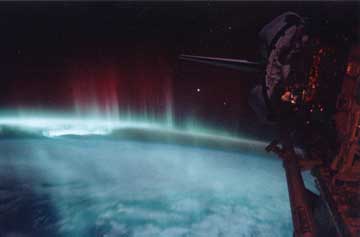|
News Notes
Space weather
Creating a formula for the Northern Lights
 |
| Red and green colors dominate this view of the aurora, as photographed from the Space Shuttle in May 1991. A new formula could help researchers predict space weather events, which can affect electronic and communication systems. Image is courtesy of Image Science and Analysis Laboratory, NASA-Johnson Space Center. |
Astronauts on a spacewalk Dec. 14 working to rewire the International Space Station were treated to a front-row view of the aurora borealis, or Northern Lights, the intricacies of which scientists do not fully understand. A new mathematical formula, however, has put researchers closer to identifying what drives the aurora and other “space weather,” which can wreak havoc on electronic systems, satellites, cell phones and even power grids.
December’s light show occurred when an unusually large ejection of plasma from the sun reached the upper atmosphere of Earth. Smaller auroras occur every day, likely caused by the interaction of the constant impact of charged particles from the sun, called the solar wind, with Earth’s upper atmosphere, says Patrick Newell, a physicist at the Johns Hopkins University Applied Physics Laboratory. The mechanism driving that interaction, however, was “not so clear,” he says. Now, a new formula, presented in December at the American Geophysical Union annual meeting in San Francisco, can provide a glimpse of the mechanism that leads to the aurora, he says, allowing researchers to predict the power of an impending storm.
To arrive at the formula, Newell and colleagues first collected various data that spanned a period of 11 and 22 years — equivalent to one or two solar cycles, during which the number of sunspots and solar storms rises and falls. The data included measurements of auroral power, solar wind, Earth’s magnetic field and more, all from U.S. Air Force, NASA and NOAA satellites.
Next, the team looked at current formulas that describe 10 different types of space weather, including the aurora and disturbances to Earth’s magnetic field. They then “tweaked” each formula until they arrived at versions that better fit the experimental data collected from the satellites, Newell says. “It was a brute force thing, to try all the possibilities,” he says.
From all the different formulas that Newell reworked, he expected to find a few individual improvements that would better describe a particular space weather event, whether it was the power of an auroral storm, or the amount of disturbance to the magnetic field. But “the amazing thing,” he says, is that a single new formula turned out to be the best predictor of all the space weather events he studied. That shows that “something fundamental is working here,” he says.
Newell thinks the formula as a whole represents the rate that Earth’s magnetic field merges with the magnetic field from the sun. Researchers have previously suggested that such merging occurs, after which the merged fields are then blown by the solar wind to the side of Earth opposite the sun, where the field piles up and becomes a source of energy for geomagnetic storms. But until now, “there has not been a global formula for predicting merging,” Newell says.
Such a formula could prove useful for models predicting space weather, says Ramon Lopez, a space physicist at the Florida Institute of Technology. For models to give a “good representation of reality,” he says, you “need to have the physics pinned down.” The significance of Newell’s work is in its “completeness,” Lopez says, in that Newell accounted for a large amount of data over a large span of time.
Lopez is already taking on Newell’s formula to see how it can be incorporated with real-time data into simulation models of space weather, to try and validate it against reality and to see how “skillful a prediction” can be made, he says. Eventually, if the models prove successful, he says, they will be turned over to the Space Environment Center in Colorado, which is part of the National Weather Service and issues space weather predictions to industry and other people who might be affected by satellite interference, which can cause electronics and cell phone outages, for example.
One factor not accounted for in the formula, however, is how space weather affects the radiation belt around Earth, which is one of the main space weather concerns for astronauts. For now, as in the December storm, astronauts will continue to take precautionary measures in the event of any significant solar storm.
Kathryn Hansen

 Subscribe
Subscribe

